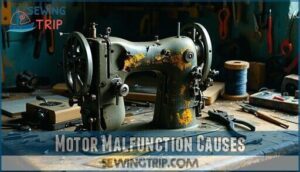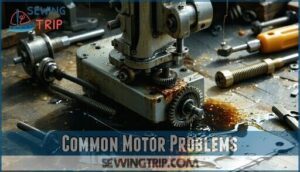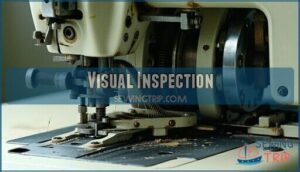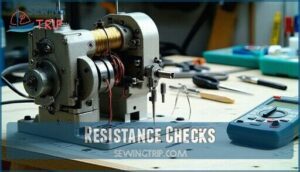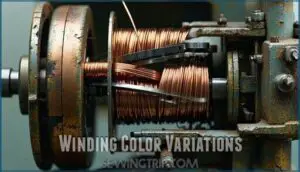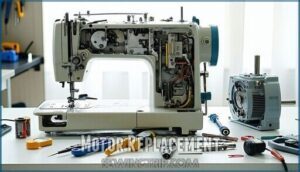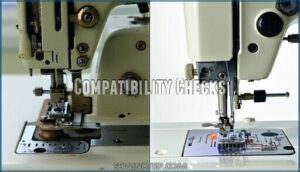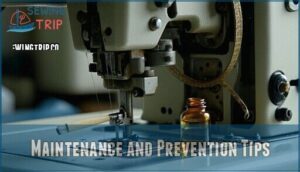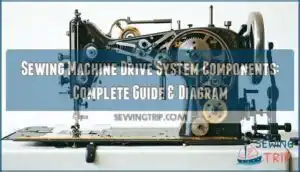This site is supported by our readers. We may earn a commission, at no cost to you, if you purchase through links.
 If your sewing machine motor’s not working, start with the basics. Check the power source—ensure the cord’s plugged in and the outlet’s functional.
If your sewing machine motor’s not working, start with the basics. Check the power source—ensure the cord’s plugged in and the outlet’s functional.
Inspect the belt; a loose or worn belt can stop the motor from engaging. Dirt and debris might also be clogging things up, so clean around the motor and internal parts.
Listen for unusual noises—grinding could mean faulty bearings or misaligned components. If it’s overheating, let it cool and check for proper lubrication.
Still stuck? A resistance check or short circuit test might pinpoint the issue. Sometimes, a replacement motor’s the best fix—stay tuned for tips!
Table Of Contents
Key Takeaways
- Check the power source, cord, and outlet to ensure the motor’s getting power.
- Inspect the belt for tension and wear; a loose or damaged belt can stop the motor.
- Clean debris around the motor and internal parts to prevent clogs and overheating.
- Listen for grinding or overheating signs—these may indicate faulty bearings or misaligned components.
Motor Malfunction Causes
You’re trying to figure out why your sewing machine motor isn’t working, and this is key to identifying the cause.
Understanding why your sewing machine motor isn’t working is the first step to getting it back to smooth operation.
You’ll need to check for common issues like power source problems, loose or worn belts, faulty bearings, or misaligned components to get your machine up and running again, which is crucial for identifying the problem and finding a solution.
Power Source Issues
You check your sewing machine’s power source.
Inspect the cord for damage, test the outlet, and verify voltage compatibility.
Use surge protection and avoid extension cords to prevent electrical issues.
A faulty power source can cause the motor not to run, so guarantee a stable connection to troubleshoot effectively.
Loose or Worn Belts
You notice your sewing machine motor runs, but the needle doesn’t move.
Loose or worn belts might be the issue.
- Inspect belt tension
- Examine belt material
- Verify pulley alignment
Consider belt replacement to prevent slippage effects and fix motor troubleshooting issues.
Faulty Bearings
You diagnose your sewing machine motor’s issue, finding faulty bearings as the culprit.
Worn-out motor bearings cause grinding or rattling noises.
Proper bearing lubrication prevents premature wear, but if noise persists, bearing replacement may be necessary, addressing shaft imbalance and motor vibration, and resolving motor noise for a smoother sewing machine motor operation.
Regular cleaning can prevent lint accumulation issues.
Misaligned Components
When dealing with misaligned components, you’ll encounter friction and resistance in your sewing machine motor.
Verify proper Bobbin Alignment and Needle Plate positioning. Misaligned parts, like Gear Meshing or Shaft Bearings, can cause issues.
Adjust Tension Disks and realign components for smooth motor troubleshooting, addressing common sewing machine motor issues to facilitate effective motor repair when the motor isn’t running.
Common Motor Problems
You’re likely experiencing one of several common issues if your sewing machine motor isn’t working, such as overheating or lack of lubrication.
By identifying the problem, you can take the first step in fixing it, and this section will help you understand the most common motor problems you may encounter, including issues related to lubrication.
Overheating Issues
You can prevent sewing machine motor overheating by allowing ventilation, sewing at moderate speeds, and monitoring ambient temperature to avoid overload protection triggers and duty cycle issues, which can cause motor burning smells.
Regular cleaning can also prevent motor overheating causes and is an important part of sewing machine maintenance to prevent motor damage.
Lack of Lubrication
To reduce friction, use sewing machine oil.
Lack of lubrication leads to component wear.
Consider:
- Oil types
- Application methods
- Lubrication frequency
Follow a schedule to maintain your sewing machine motor, reducing the risk of overheating and breakdowns due to neglect of friction reduction.
Belt Issues
You’re troubleshooting your sewing machine motor. Now, let’s address belt issues.
Check the belt tension and alignment.
- Inspect belt material
- Check pulley condition
- Adjust belt alignment
- Perform belt replacement
Monitor belt tension to prevent slippage and guarantee smooth motor operation.
Voltage Fluctuations
You face voltage fluctuations, straining your sewing machine motor.
Use surge protection and test outlet voltage compatibility to prevent power surges.
Avoid extension cords, as they reduce power flow, and verify your power source settings are correct to prevent motor damage and weak performance, aiding in motor troubleshooting and resolving electrical issues.
Dirt and Debris
Your sewing machine’s motor can be compromised by lint buildup and debris accumulation.
Regular motor cleaning prevents component contamination and airflow obstruction. Check for dirt and debris, then clean with a brush or cloth.
Maintain a consistent cleaning frequency to avoid motor grime buildup, including lint and dust accumulation, ensuring your machine runs smoothly and frustration-free.
Motor Troubleshooting Steps
You’re now going to troubleshoot your sewing machine motor, and this is a key part of the process.
By conducting a visual inspection, checking resistance, and examining winding color variations, you’ll be able to identify common issues and get your motor working again.
Visual Inspection
You’re now inspecting your sewing machine motor.
Inspect your sewing machine motor closely to spot wear, loose wires, or debris—small details can reveal big solutions.
Check for debris accumulation, loose wires, and belt alignment. Look for component damage and verify the wiring condition.
A visual overview can reveal issues, so examine the motor closely, checking for signs of wear and tear, to identify why your sewing machine motor isn’t running, and look for component damage.
Resistance Checks
You’ll use an ohmmeter to test winding resistance, comparing stator segments for consistent readings, checking for short circuits or winding damage, and identifying component resistance issues, a key step in motor troubleshooting and repair.
Especially when the motor isn’t running due to electrical circuit issues, this process is crucial.
You can find a sewing machine ohmmeter online, which is a useful tool for diagnosing issues with electrical circuit problems, and it plays a significant role in troubleshooting and repair.
Winding Color Variations
To identify motor issues, check winding color variations.
Look for:
- Discoloration
- Uneven windings
- Overheating indicators
- Insulation damage signs
Then compare resistance readings on stator segments during rotor inspection for accurate motor troubleshooting and repair.
Regular cleaning helps prevent lint accumulation causing overheating to ensure proper maintenance.
Short Circuits
Short circuits are tricky electrical issues in motor repair.
Check for winding resistance inconsistencies; they reveal motor winding short circuits.
Inspect the stator for insulation failure or discoloration.
Examine rotor segments; uneven readings signal trouble.
Core shorts, where windings are shorted to core, cause electrical issues.
Thorough stator examination guarantees clarity.
| Symptom | Possible Cause |
|---|---|
| Component sparking | Stator shorts |
| Motor not working | Rotor shorts |
| Overheating | Insulation failure |
The table above outlines key symptoms and their possible causes, including stator shorts and rotor shorts.
Repair and Replacement Options
You’re now considering repair and replacement options for your sewing machine motor, which can be a bit overwhelming.
You’ll need to weigh the costs and benefits of fixing or replacing the motor, and consider factors like compatibility and professional installation to get your machine up and running again.
Field Coil Rewinding
When rewinding a sewing machine motor’s field coil, follow these steps:
- Inspect the commutator
- Measure winding resistance
- Rewind coils precisely
- Test for shorts.
This process can fix insulation failure, requiring precision and proper coil material, often needing professional expertise for successful motor repair and troubleshooting.
You may need to source a rewind coil during this process.
Motor Replacement
Sometimes, sewing machine motor failure means it’s time for a sewing machine motor replacement. Before you buy, motor compatibility matters! Double-check your model.
Consider motor replacement options and warranty implications. Understanding available motor choices can help you make the right decision.
Follow a reliable motor repair guide. If it’s tricky, get professional assistance with the installation process. Choosing quality can save you on sewing machine motor cost.
| Component | Importance | Notes |
|---|---|---|
| Voltage | Critical | Match your machine |
| Size | Essential | Must physically fit |
| Connectors | Required | For power and control |
Cost-Benefit Analysis
You weigh repair vs. replace, considering sewing machine motor cost, lifespan, and performance.
DIY fixes can save money, but constant servicing may indicate replacement is better, offering long-term savings and reducing downtime costs through a thorough cost-benefit analysis of motor replacement options, which can lead to long-term savings.
Compatibility Checks
When replacing your sewing machine motor, verify compatibility by checking:
- Voltage Matching
- Dimensional Accuracy
- Connector Types
- Mounting Brackets
- Motor Size to avoid damage and guarantee proper function, verifying your new motor is a perfect match for your machine.
This process is crucial to ensure that your new motor is a perfect match for your machine.
Maintenance and Prevention Tips
You can prevent sewing machine motor issues by following a few simple tips.
By keeping your machine clean, following a lubrication schedule, and checking thread tension, you can help extend the life of your motor and prevent common problems. By keeping your machine clean, you can help extend the life of your motor and prevent common problems.
Regular Cleaning
You tackle lint removal and dust accumulation using a soft brush.
Regular motor cleaning, every three months, prevents grime buildup.
This keeps your sewing machine running smoothly, preventing motor lint buildup and dust accumulation, ensuring safe practices and proper component cleaning, which is crucial for maintaining your machine and preventing damage, and it also ensures proper functioning.
Lubrication Schedule
By following a motor lubrication schedule, you guarantee smooth operation.
Use high-quality Oil Types, targeting moving parts.
To maintain stitch quality, consider regular sewing machine oiling.
Key points include:
- Checking Frequency Matters
- Understanding Component Specifics
- Avoiding Over-Lubrication for proper motor maintenance and lubrication.
Tension Checks
Thread tension might seem minor, but it’s a major player in stitch quality and sewing machine motor health.
Regular tension checks keep everything running smoothly. Clear lint from the tension unit with a soft brush, and match bobbin tension to your fabric type.
Misaligned needle tension can strain the motor, leading to unnecessary wear or even sewing machine repair. A quick adjustment often solves stitching issues and prevents motor troubleshooting headaches.
Remember, balanced tension isn’t just about looks—it saves your motor from extra work, which is a key aspect of maintaining good sewing machine motor health and ensuring stitch quality.
Proper Storage and Handling
Keeping your sewing machine in top shape starts with proper storage and handling. Store it in a cool, dry place to avoid moisture damage, and always use motor protective covers for dust prevention.
Manage cords neatly to prevent tangles and guarantee gentle handling to avoid impacts. A motor sturdy shelf works well for stability.
- Cool Storage: Avoid damp environments.
- Cord Management: Prevent fraying or knots.
- Protective Covers: Shield from dust and debris.
Frequently Asked Questions (FAQs)
How do I know if my sewing machine motor is bad?
Like a car that won’t start, a bad motor shows signs—overheating, strange noises, or no power.
Check for loose wires, inspect the belt, test resistance, and verify proper voltage before considering a replacement.
Why did my sewing machine stop working?
You’ll need to check the power cord, outlet, and voltage compatibility to troubleshoot why your sewing machine stopped working, ensuring all connections are secure and functional.
Why is my sewing machine wheel not moving?
Check for jammed fabric, tangled thread, or debris in the bobbin area.
Inspect the handwheel for tightness, and make certain the clutch knob isn’t engaged.
If nothing moves, the motor or belt might need attention.
What is the most common sewing machine problem?
It’s like the universe conspires against you—thread tension issues top the list.
Misaligned settings or poor threading can tangle threads, jam needles, and disrupt stitching.
Adjust tension, rethread carefully, and test on scrap fabric.
Why is my sewing machine motor not running?
Your motor mightn’t run due to a loose power cord, faulty foot pedal, or internal damage.
Inspect connections, check for blown fuses, and verify the machine’s properly plugged into a working outlet.
How to identify motor-specific electrical circuit issues?
Electrical circuits can be sneaky troublemakers.
Use a multimeter to test continuity in wires, inspect for frayed insulation, and verify connections at terminals.
Look for burnt marks or loose components that scream, "Fix me now!
Can a damaged foot pedal affect motor function?
A faulty foot pedal can absolutely disrupt motor function.
If it’s damaged or has loose connections, it may fail to send consistent signals, causing the motor to run intermittently, too slowly, or not at all.
How do improper stitch settings impact the motor?
When stitch settings are off, it’s like asking a car to drive uphill in the wrong gear—your motor strains, overheats, or stalls.
Make certain proper tension, thread alignment, and bobbin placement to avoid unnecessary stress, as this will help prevent your motor from straining, overheating, or stalling.
What safety precautions prevent motor-related accidents?
Unplug the machine before any maintenance, wear safety glasses during repairs, and make certain proper ventilation to avoid overheating.
Keep cords intact, remove obstructions promptly, and never exceed the machine’s operational limits for safe usage.
How to diagnose unusual smells from the motor?
When your motor smells like a burnt toast factory, check for overheating, debris buildup, or frayed wires.
Clean vents, inspect for melted components, and verify proper lubrication.
Persistent smells? It’s time to call a technician.
Conclusion
Think of your sewing machine motor as the heart of your machine—it needs care to keep pumping smoothly.
When your sewing machine motor’s not working, start with simple fixes like checking power, cleaning debris, and inspecting belts.
If deeper issues like overheating or faulty bearings arise, troubleshooting steps like resistance checks can help.
Sometimes, replacing the motor is the smartest move, and regular maintenance, like cleaning and lubrication, guarantees your motor runs seamlessly, saving you time and frustration, which is a key part of troubleshooting.

